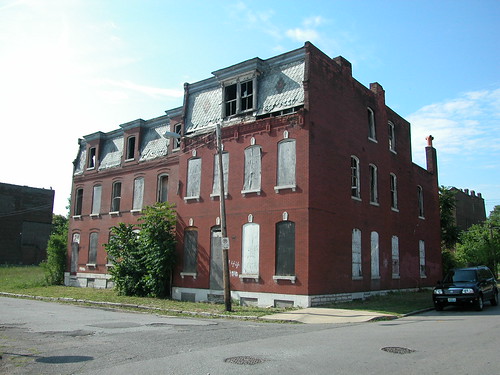 In March, I wrote about the tragic loss of an entire block of buildings in St. Louis Place due to brick rustling. Many of the houses on the 1900 block of Wright Street between Florissant Avenue and North 20th Street were owned by Paul J. McKee, Jr., but three were owned by others. (See "Brick Rustlers Decimate Wright Street Block," March 26, 2008.) Two buildings comprising a magnificent row had been the property of DHP Investments, the failed company led by Doug Hartmann that left over 120 historic city buildings in various states of abandonment, including the landmark Nord St. Louis Turnverein. Hartmann's buildings here were imposing three-story buildings with elegant masonry details, mansard roofs punctuated by squared dormers and even intact cast iron balconies.
In March, I wrote about the tragic loss of an entire block of buildings in St. Louis Place due to brick rustling. Many of the houses on the 1900 block of Wright Street between Florissant Avenue and North 20th Street were owned by Paul J. McKee, Jr., but three were owned by others. (See "Brick Rustlers Decimate Wright Street Block," March 26, 2008.) Two buildings comprising a magnificent row had been the property of DHP Investments, the failed company led by Doug Hartmann that left over 120 historic city buildings in various states of abandonment, including the landmark Nord St. Louis Turnverein. Hartmann's buildings here were imposing three-story buildings with elegant masonry details, mansard roofs punctuated by squared dormers and even intact cast iron balconies.Missing from my earlier coverages was mention of a row that stood across the alley on Dodier Street until this February. The two buildings at 1944-50 Dodier Street were not as exotic as their neighbors to the south, but they were every much as responsible for creating the sense of place for the neighborhood. The best part of these two buildings was their relationship: the eastern tenement building was wide and set back from the street, while its conjoined neighbor with commercial space came right up to the sidewalks on both Dodier and 20th streets. This pair beautifully demonstrated the order or urban space as it recedes from the public sphere to the semi-private. Here, the public was that which is immediate to the right-of-way, while the semi-private was removed just enough to mark the boundary between residents and passers-by. Both buildings were completely urban.
The details were also lovely. The tenement's brick dormers pack a punch not found in the small belt courses and elegant but typical stone sills. Next door, a corbelled cornice, central dormer and vivid stone keystones give a plain brick wall pizazz. The details are common for vernacular buildings of the 1880s and 1890s, when these were built. While the rarity of such buildings and their details makes them more precious, their historic commonality provides the real significance. There was a time when such finesse was a matter of course even in working class housing.
Alas, these buildings fell into the hands of the city's Land Reutilization Authority by the 1970s, and were vacant for awhile before Victor Casine (whose ownership of another building recently was profiled in the Vital Voice) purchased them in 1982. Casine promised rehabilitation, but did little other than allow further deterioration. The city's Building Division reported the buildings as vacant for every year that Casine owned them. Numerous citations led to one suit filed by the city against Casine. Casine himself sued the city in 1989 for supposedly damaging the property when the Forestry Division mowed the overgrowth Casine did not trim himself.
After three years in which Casine did not pay outstanding liens and taxes on the property, the Sheriff auctioned the houses in 2003. This time was on the cusp of McKee's purchasing, and so the buildings found no bidder. The Land Reutilization Authority took title once more, and after the rear walls collapsed was granted emergency demolition by the Building Division in January 2008. And so it goes. Those new to following land speculation and demolition in St. Louis Place should know that the tragedy is not new and has never been closer to real solutions as it is now. A long time ago, buildings bit the dust without so much as a photograph taken and owners let property decay without a call to the alderman, let alone protests at City Hall. Now, there is relatively wide attention on the future of the neighborhood. From that attention could come action.





1 comment:
Lawsuit under Federal Fair Housing Act. What else could not only prevent McKee, but remove his presence from our City? He accquired his property through duress, therefore he has no right, to them and certianly not to 100,000,000 fom the State. Do citizens know about this option? Does leadership exist?
Post a Comment